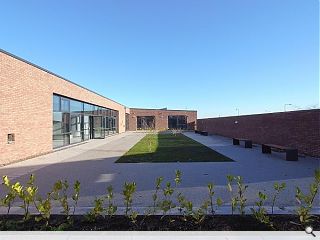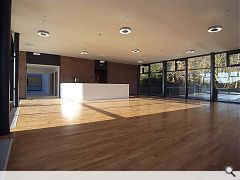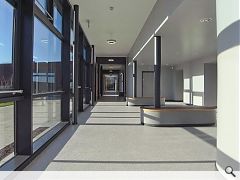Craigshill Learning Centre
4 Apr 2011
With a mosque, fire station and Masonic lodge for company the Craigshill Learning Disability Centre, Livingston, stands in a surprisingly eclectic quarter of a burgeoning New Town. It is perhaps fitting therefore that macmon (in conjunction with an advisory group including Ace Advocacy), who are celebrating their 20th anniversary, should be selected by West Lothian Council to design a neighbour of quiet subtlety to slot into this variegated context. Appointed following a competitive interview in response to an OJEU advertisement the newly unwrapped the centre marks the perfect birthday gift for the practice, a reminder that big things can sometimes come in small packages.
Located on a Greenfield site less than a mile from Livingston town centre, the £3.4m centre replaces two outdated facilities at Blackburn and Linlithgow, focusing the provision of support services within a single unit offering structured day care, an autistic unit, a behavioural therapy centre, an arts and crafts room, music room, IT suite and a courtyard sensory garden. Not only is the facility much better equipped to care for adults with learning difficulties it boasts ready access to local shops, transport connections and the nearby Craigswood Sports Centre, proximity which ensures easy outreach to the wider community through a shared café space.Some 110 adults and 23 staff can be accommodated in the 1,550m2 single storey structure, a simple form comprising timber, curtain walling and handmade brick. This emphasis on natural materials and those with low-embodied energy, in preference to ‘composite’ materials, serves to promote a conscious blend between nature and man. Such principles are extended to ensure the building achieves high insulation values throughout, exceeding backstop Building Standards’ requirements, through the use of high efficiency heating and hot-water services and the use of Low E, argon filled double glazing throughout.
A forecourt for specialised suites and café terrace space and no less than three principal entry points; a main entrance providing access to reception and café, a secondary entrance to two specialised suites and a third entrance for back of house services. The Centre forms the flagship for a range of important new services for people with disabilities, their carers and local communities and is intended to demonstrate the most up to date thinking about designing and building for people with severe learning disabilities, challenging behaviours and sensory impairments.
Nestling into its site the snug low slung brick structure is the latest refinement of macmon’s pioneering work in the field of community and healthcare, a lineage which includes work on the Glasgow Homeopathic Hospital, Birnam Institute and Gartnavel Royal Hospital. At the present time the practice is also participating in mental healthcare developments at The State Hospital, Murray Royal Hospital in Perth for NHS Tayside and Framework Redevelopment for NHS Greater Glasgow and Clyde and NHS Highland. In refining these solutions for its local context macmon have fashioned a simple, elegant designs which serves to both maximise natural light in and views out, echoing a growing maturation of the practice as it has grown so too has the quality of their work.
Engaging with neighbours, parents, carers and staff macmon resolved a number of issues, notably insertion of common roads access to the constrained site by opening a single one way vehicular loop to feed an entry courtyard and car park, adding tonal texturing to the paving alongside the use of bollards and drop kerbs to ensure the safety of pedestrians. Shared by the mosque and lodge this common access necessitated close collaboration in pursuit of a mutually beneficial solution. The result is an expansive drop off area which allows mini buses to manoeuvre easily whilst an attention to detail sees porous paving introduced to alleviate pooling in the low lying site.
Constructed on a large rectangular plot the unit is hemmed in to the north by woodlands the expanse of foliage provides an inherently therapeutic natural environment but also restricts opportunities for the design team who had to abide by the Woodland Trust’s margins in order to safeguard root systems. To the south a neighbouring mosque prompted a generous set back with the resulting space utilised as a therapy courtyard and garden, this serves the dual purpose of deferring to the structure whilst exposing the southerly aspect to an optimised influx of light. Fixed road access defines the sites eastern boundary whilst an existing public pathway skirts the sites western perimeter.
Craigshill’s standout feature – its green roof, is actually invisible from the street and inaccessible from within. The only way to catch site of this landscaped ceiling is to climb a nearby fire training tower form whose lofty perch can be surveyed the site and its wider context. Composed of soil and aggregate from the site, the brown roof encourages biodiversity through natural plant growth and stimulation of local insect populations, becoming green over time just as a cleared field would. Since there is no dominant species of planting, wildlife is more likely to proliferate. The roof also requires no maintenance with fallen leaves from the woodlands simply decomposing in situ eliminating the need to clean gutters and drains. Nonetheless, a man-safe system has been provided for routine inspections.
Internally circulation is organised around a principal axis corridor from which all services and amenities branch off. Stretching to the entire width of the accommodation this node also doubles as an amenity and activity space, serving to promote passive observation and social interaction whilst benefiting from copious levels of natural light. Such passive surveillance measures, in addition to overt fencing and CCTV, ensure site security in accordance with Secure by Design standards. Each room also contains provision for openable windows and/or passive stack ventilation to minimise reliance on mechanical interventions.
Centrepiece of the facility is its sensory garden however, a large communal space at the heart of the development which affords a contemplative environment for people to recuperate within a generously planted space which provides valuable amenity for adjacent rooms and suites. It is sheltered by projecting wings of specialist facilities which stretch out from the principal accommodation block with speciality suites, an art room and music rooms providing a marriage between outdoors and indoors which serves both to facilitate a private sense of enclosure whilst exploiting open aspect to adjoining woodland. Planting has also been designed to provide shaded areas to select locations in summer.
Craigshill serves as a reminder that good architecture need not resort to bombastic iconography to make an impact, considered subtlety and quiet forms often win out in the longer term. It is that eye for the long game which has stood macmon in good stead from their early days as Maclachlan Monaghan Architects, when the practice was first founded back in 1991. This strategy has been borne out by macmon’s expansion to its present day complement of 15 individuals, a growth spurt which has seen the practice outgrow its existing offices to relocate to bigger premises in Charing Cross, Glasgow. It bodes well for the future and the architects next 20 years in business.
CRAIGSHILL LEARNING DISABILITY CENTRE
Client: West Lothian Council
Contract and project value: £3.4m
Completion: October 2010
Contractor: Morrison Construction
architects and design team leader: macmon architects
quantity surveyors: Neilson Binnie McKenzie,
Landscape architects: Keppie,
M&E engineers: Rybka,
civil & structural engineers: Scott Wilson,
|
|





